Seasons – Summer 2015
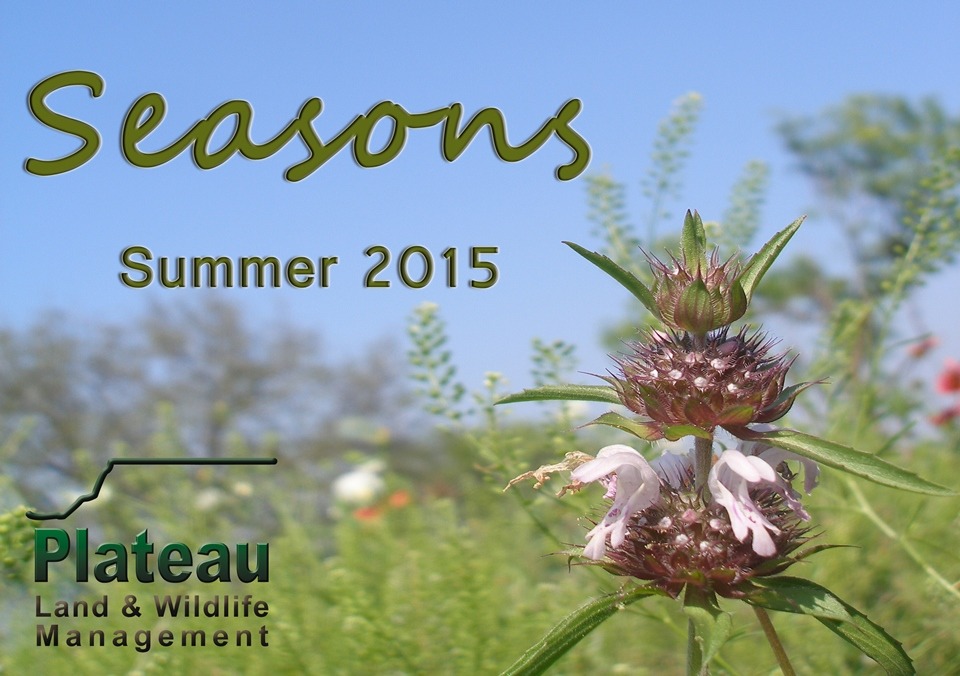
From the Plateau Land & Wildlife Management Team,
This year has passed us by faster than we could have imagined. And here we are in the midst of another hot Texas summer. Thus far, this year has brought our great state record rainfall. Rainfall that was deeply needed, allowing the flora and fauna to thrive. As we prepare ourselves for the heat and all the fun activities that may include, we must also remember how summer can affect our land. Your land may be going through the recovery process from the recent flooding rains after a lengthy drought, or you may need brush management ideas or services. Whatever your need this summer, we hope you find useful information in this issue of Seasons where we cover an array of issues that affect landowners during this time of year.
We hope you enjoy the read and everything this summer has to offer, and if there’s any way Plateau can help you protect, enhance or better to enjoy your land during this special season, just give us a call. We’ll be here when you need us.
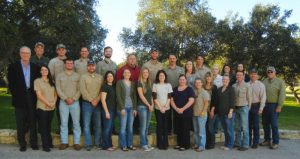 Until next season and Seasons,
Until next season and Seasons,
The Plateau Team
Table of Contents
Summertime Chemical Control of Mesquite and Prickly Pear
The Great Texas Birding Classic- The Big Day
Summer Wildlife Management Activities Checklist
Dangerous Wildlife
Hays County: Trinity Aquifer Annexation Now Official
Plateau Land Group Featured Listing
Summertime Chemical Control of Mesquite and Prickly Pear
By Shane Kiefer, Director of Ecological Services
Many of you are conducting brush management as part of your wildlife management plan or may realize the need for brush management. Plateau advocates thoughtful removal of native brush species, because it is important to realize that almost all species of brush (no matter how weedy, prickly, or annoying) have some value to wildlife as food, cover, or both. This is certainly true for prickly pear and mesquite which are beneficial to quail, wild turkey, white-tailed deer, songbirds, and small mammals and reptiles. However, diversity is the key in wildlife management, so you can have too much of a good thing when one or a few species dominate the habitat. When these plants become a problem, they can be a challenge to control. Summer is the best time for chemical treatments of these species. If you are in need of proven control methods for mesquite and prickly pear, Plateau can help.
Unlike Ashe juniper and eastern red cedar, mesquite and prickly pear can be quite difficult to control with mechanical removal methods such as cutting. The reason lies below the soil in the root crown of mesquite. When the top of the plant is killed by cutting or fire, it awakens dozens of growth points (buds) in the root crown. This is why you often see mesquite trees with many small stems originating from the base. These trees have been treated before, often multiple times, in a vain attempt to kill them. Prickly pear and other cacti can sprout roots from the pads themselves when left in contact with the soil. Chopping prickly pear exacerbates any problems by creating dozens of new plants. Care must be taken to remove the entire plant and to avoid leaving any part in contact with the ground. When grubbing mesquite, you must be sure to remove all material to a point below the root crown. Grubbing can be an effective and selective mechanical method, and Plateau has partners who do a very good job of grubbing when it is the best choice, but if you have very small mesquite or more than 50 plants/acre, you may consider Individual Plant Treatment (IPT) with herbicides.
The list of effective herbicides is long, and treatment methods are numerous. I have selected a few proven control methods to describe below. These are designed to be cost efficient and highly effective methods for selectively controlling mesquite and prickly pear using the Brush Busters methodology developed by Drs. Allan McGinty and Darrell N. Ueckert of the Texas A&M University System.
Mesquite can be controlled chemically using three different methods: cut-stump, stem spraying, and leaf spraying. All should result in at least 70% kill if done properly. The method you choose should be based on the size and shape of mesquite you have. For large mesquite (trunk diameter >4 inches, taller than 8 ft) with rough bark and one or a few basal stems, the cut-stump method is most effective. This involves top killing the tree by cutting almost to ground level and then spraying the stumps with a mixture of 15% Remedy in diesel fuel or vegetable oil.
For smaller trees and shrubs (diameter <4 inches) with smooth bark and one or a few basal stems, stem spraying with a Remedy/diesel mixture containing 15-25% Remedy by volume is effective and does not require cutting in advance of treatment. Every stem must be well coated from the ground to 12 inches high to ensure a complete kill, so multi-stemmed plants can be difficult to treat with this method. For multi-stemmed plants, less than 8 ft tall, foliar (leaf-spraying) applications are best. This method involves using larger quantities of a lower concentration mixture. A 1/2% Remedy/1/2% Reclaim solution in water works well, and a relatively new herbicide called Sendero® has shown great promise with a 1% mix in water. A surfactant should also be added, and a water-soluble dye such as Hi-Lite can be added to make it easy to keep track of treated plants. Timing is extremely important with the leaf spray method. The tree must be actively growing and transporting sugars to the roots for the herbicide to be effective. When the mesquite leaves turn from light to dark green in the summer, the time is right for leaf spraying. Spraying can continue until September 1st unless you are in south Texas when the cut-off is July 31st for maximum effectiveness. The rains this year may have shifted the treatment period back a bit in some areas, so get a professional opinion on-site before treating mesquite with the leaf spray method.
Prickly pear can be controlled though a high-volume foliar treatment with a 1% solution of Surmount® in water with a surfactant. Remember to spray both sides of the pads. This is a slow treatment, taking up to 2-3 years for maximum kill, though results can be seen quickly when conditions are right. Combining a prescribed fire with pad spraying can hasten the process, as can mechanically injuring the pads prior to application. The active ingredients in Surmount® are picloram and fluroxypyr, which are federally regulated herbicides. A pesticide applicator’s license is required to purchase and use it. Plateau maintains a commercial applicator’s license so we can assist you.
Any herbicide must be used with caution to avoid damage to desirable non-target species. Remember that brush management for wildlife often involves judicious removal of individual plants to increase production of desirable grasses, forbs, and shrubs. Select tall clumps of prickly pear should be left for the excellent food and cover they provide and small groups of mesquite at 50-75 yard intervals can provide essential cover for quail and small mammals. Maintaining brush for cover and food is important to a wide-variety of species, and gives you opportunities for other activities such as half-cutting mesquite. Talk to Plateau before beginning any chemical treatments or brush management to ensure that your choice of herbicide and treatment methodology is suitable for your problem species. Plateau can save you a lot of wasted time and money with proper planning. As always you can be sure you are getting the best information available when you get it from your Plateau biologist.
Back to TopBack to Top
The Great Texas Birding Classic- The Big Day
By Quinn Emmering
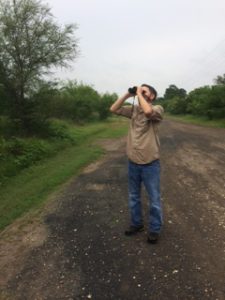 On May 6 at 4:00 AM, four intrepid, but groggy biologists from Plateau embarked from south Austin to compete in the 2015 Great Texas Birding Classic (GTBC). The GTBC is an annual birding competition held throughout Texas each spring. Teams competing in the Regional Big Day tournament select one of nine Texas ecoregions to bird, with goal of finding, by sight or sound, as many species as possible in a 24-hour period. With the aid of many sponsors the GTBC raises conservation funds, awareness and appreciation of Texas’s diverse birdlife, the greatest of any state in the country with more than 640 species recorded!!
On May 6 at 4:00 AM, four intrepid, but groggy biologists from Plateau embarked from south Austin to compete in the 2015 Great Texas Birding Classic (GTBC). The GTBC is an annual birding competition held throughout Texas each spring. Teams competing in the Regional Big Day tournament select one of nine Texas ecoregions to bird, with goal of finding, by sight or sound, as many species as possible in a 24-hour period. With the aid of many sponsors the GTBC raises conservation funds, awareness and appreciation of Texas’s diverse birdlife, the greatest of any state in the country with more than 640 species recorded!!
So what’s the recipe for winning a GTBC? First, you need four savvy birders – Mark Gray, James Hall, Shantel Porterfield and Quinn Emmering. Second, do your homework to wisely select what hotspots in your chosen region will net you the most species in the shortest amount of time. For the Plateau team, competing in the Heart of Texas, West region, that meant driving three hours just to begin their count in Uvalde County and searching such sites as Cook’s Slough Nature Center, Chalk Bluff Park and Kickapoo Cavern State Park. Next, maintain constant vigilance at all times for new birds! Not just at planned stops but also while scanning out the car window at 70 mph and during pit stops. And this means everyone too! All team members must identify 95% of all birds recorded. You don’t want to be the one who misses that clutch bird that could make the difference between winning and losing! Lastly, just have fun… even after driving for 18 hours and the jokes have seriously degraded as you are delirious with fatigue. The point is not winning. It’s getting outside with friends to see the abundance of great birds, beasts and landscapes only Texas has to offer.
Although, winning does sweeten the deal – Plateau’s team took first place in the Heart of Texas West region recording 116 species in 12 hours of solid birding!!
Other interesting stats and info about the 2015 GTBC you may want to add:
- 100 teams registered
- About 530 participants
- 413 species were recorded by participants
- $25,000 in conservation grants were donated
Back to TopBack to Top
Summer Wildlife Management Activities Checklist
By Kameron Bain, Business Development Manager
Happy summer! With the recent record breaking rains the majority of our Texas landscape is lush, green and full of activity. But on the flip-side to that, because of this rain, the spring did not allow much opportunity to enjoy the great outdoors. Thus, some wildlife management landowners maybe finding themselves behind on their activities. Thankfully, we are just at the halfway mark for the year and the Summer offers a variety of activities to help you catch up.
- Chemical Brush Management
- Managed Lands Deer Permit (MLDP) Paperwork- Due August 15
- Deer Surveys- Start in August
- Pond Construction
- Pond Renovations and Repair
- Imported Red Fire Ant Control
- Strip Mowing- Late July and August
- Half-cutting
- Supplemental Water Maintenance
- Small Mammal Surveys
Back to TopBack to Top
Dangerous Wildlife
By James Hall, Staff Biologist
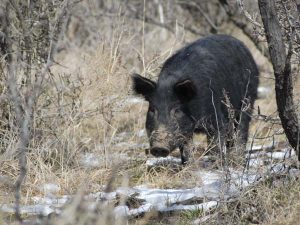
May be hazardous to your habitat.
Landowners are already aware of the splendor of rural Texas lands, with its rich scenery and unique mix of flora and fauna. Under the auspices of prudent stewardship, private lands can recover from the limitations imposed on them from intensive agricultural practices. As a result, the native beauty improves, plant and animal life can flourish, and the chances of encountering a broader diversity of wildlife becomes more likely as you walk and work the land. However, one may experience trepidation when coming across a wild animal in its natural habitat. Some species are considered scary or dangerous, while others have an impact to habitat health. Most wildlife generally avoid human contact, are not dangerous, and do not cause extensive damage to personal property or wildlands, yet, it is important for land stewards to practice awareness when in the wilds, not only for safety during a wildlife encounter, but also to understand when control efforts are necessary.
Snakes are a common predator in Texas, and one of the most feared wild animals. A mentality shared among some ranchers is that “the only good snake is a dead snake”. Snakes are generally regarded as dangerous, and from a safety perspective, they should always be treated with great respect. The average landowner can likely identify a copperhead or a rattlesnake, but snake species are numerous and diverse, and the vast majority are non-venomous. Some types mimic behavior or patterns of venomous species (e.g. bull snakes will vibrate their tails in dry leaves which sounds amazingly like a rattlesnake buzzing), thus it is safer to consider all snakes venomous and avoid handling them without a professional. However, this consideration does not demand a blanket kill-on-sight policy. Snakes play an important role in a balanced ecosystem, including contribution to rodent population control. Snakes can be easily avoided if caution is exercised at all times. A rattlesnake seeking shade under the steps of your front porch is another matter.
Just like snakes, not all varmints are dangerous nor do they require control, but virtually every ranch has a “nuisance” wildlife species of some kind. Familiar examples of these pests include imported red fire ants, feral hogs, raccoons, coyotes, foxes, skunks, beavers, and porcupines. With native predators the “nuisance” is a people problem rather than a wildlife problem. Most landowners are excited to catch a glimpse of a fox (who eats more mice than game species), skunks are an important food source for Great Horned Owls, beavers create valuable wetland habitat that attracts other wildlife, and porcupines can damage trees but are rarely a real concern for tree health unless they are attacking an orchard.
Fire ants and feral hogs are both non-native, and cause considerable damage to habitat and native wildlife populations. Fire ants have devastating affects to local insect populations (an important food source for songbirds, turkey, and quail). They are also predators to native ant species, and aggressive to anything that comes into contact with their mounds, including an unsuspecting human foot. Feral hogs can be dangerous, but generally avoid humans when encountered. More importantly, they compete with white-tailed deer and other animals for forage. They also contribute to erosion and the spread of non-native vegetation through their destructive rooting. As a result, the monitoring and control of these species should be considered a management priority and can count towards a property’s wildlife management plan under the predator control category.
Raccoons are an example of a native predator and the source of much consternation to wildlife managers. These small carnivores are highly adaptable to human habitation in both urban and rural settings. Their populations can become exacerbated with the availability of human-provided food (deer feeders, unsecured trash), at which point control efforts may need to be implemented. Raccoons are also known to destroy deer feeders in an attempt to reach the available corn or protein pellets, though this practice does not constitute enough of a reason, from an ecological standpoint, to control their numbers. Utilizing a game camera, placed at a feeder or wildlife water source may help gauge raccoon numbers as well as other predator species and help land managers determine if control is necessary.
What many landowners and even land managers do not realize is that native predator control is often a futile effort. The desired outcome of increasing prey numbers is not always achievable. Predator reduction efforts to increase quail numbers is rarely successful. The level of control needed to have even a minor benefit is often beyond the abilities of most landowners. Any wildlife biologist will tell you that quality habitat is much more important and effective than predator control. Reducing deer predators such as coyotes may actually be counterproductive as deer are often a much larger problem for central Texas lands than any of the predators being controlled.
White-tailed deer are not predators, and yet can be far more harmful to the landscape than many of the aforementioned species. Rarely are deer a danger to humans, and most of the “threat” they pose relates to traffic accidents. However, a lack of natural controls and an increase in feeding has resulted in heavily inflated deer populations across the state, directly impacting desirable tree establishment. With high deer numbers, feral hogs, and increasing numbers of exotic deer hardwood recruitment is exposed to heavy utilization and degradation. Implementing monitoring and control efforts, just like any other potential nuisance species, is strongly encouraged. Beyond observing scat and tracks, monitoring the habitat is important. Observable browse pressure on seedling oaks and desirable shrubs can offer some insight into deer numbers.
Rural Texas provides landowners with recreation and enjoyment. Wildlife watching and hunting are coveted activities in Texas, and the occasional startling encounter with an animal keeps us on our toes. Each wildlife species has a unique natural history, and understanding their place in the ecosystem will aid in avoiding injury and promote informed management decisions.
Back to TopBack to Top
News From Our Sister Company Braun & Gresham, PLLC
Hays County: Trinity Aquifer Annexation Now Official
After a long 84th Texas legislative session, HB 3405, also fittingly referred to as the Lazarus bill, has now become law. This law was made possible thanks to State Representative Jason Isaac, Senator Donna Campbell, County Commissioner Will Conley, County Commissioner Ray Whisenant, Landowner Bill Johnson, Attorneys David Braun and Cassie Gresham, Davis Kaufman, PLLC., BSEACD and a network of hard-working Hays County landowners.
For further information, CLICK HERE
Back to TopBack to Top
Plateau Land Group Featured Listing
Sustainable Farm Operation, Godfrey Farm in Cameron & Milam Counties
 This is not only the sale of a great productive farm, but of a business, as well. The property would serve well as a farm homestead with a business income, or as a fully-sustainable “off the grid” property.
This is not only the sale of a great productive farm, but of a business, as well. The property would serve well as a farm homestead with a business income, or as a fully-sustainable “off the grid” property.
View all of Plateau Land Group’s listings.
Back to TopBack to Top







Sorry, the comment form is closed at this time.